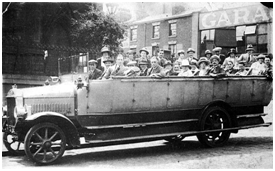One of the few pleasures that you could look forward too as an employee in the Eighteen hundred’s was the annual works day off. This was where your gracious employers, with much wailing and gnashing of teeth due to the money they would lose that day allowed their work force out to the seaside or the country. This meant that for a little while at least they could see daylight and feel the wind on there face. They were expected to work harder for the next 363 days though. There had to be some way of transporting this mob of primary and secondary industry workers out and about was to use the horse and cart or Charabanc (pronounced sharrabang, basically) that would mean they could be there and back again at a reasonable time. In this modern age you’d visit the website of a Coach hire Gloucester firm such as https://www.johndixtravel.co.uk/ for example, but this was the first of it’s type and effectively the beings f the Coach before and during motorisation.
The idea was simple enough and was first developed in France, hence with it’s as has the name Charabanc. Effectively all that was needed was flat Cart that then had the sides built up. Inside the cart there were long wooden benches installed with a thin back rest. Sometimes unused pulpits were nailed in. This allowed for a relatively comfortable ride. Due to the sheer numbers of people in the back this was not considered to be work for just one horse and a team of up to four were usually employed to pull it.

It soon became clear that this was an excellent way of transporting people to and fro. Could this not be used in some other capacity in city’s as well? Here we can see the inaugural appearance of the Coach and the bus. It soon became clear to employers that operating a round charabanc system that workers could collect would mean that they could arrive and time and at a series of locations. This was especially true if they were farm labourers and, whilst this was shifting towards an urban population, there was still a lot of call for it. As it was not always possible to have housing around the factory site the Charabanc system was easily transformed into an urban setting.
The invention of the internal combustion technology soon allowed for a motorised version to appear. This enabled the masses to experience the motor world as the ownership of a car itself was still many decades beyond the reach of those on a meagre income. The Charabanc does help to revolutionise the workforce though in that they are able to work or find newer employment throughout the town, or even any other city as the county is opened up. Therefore, new positions in other companies that would have been impossible previously due to the distance became more accessible.

